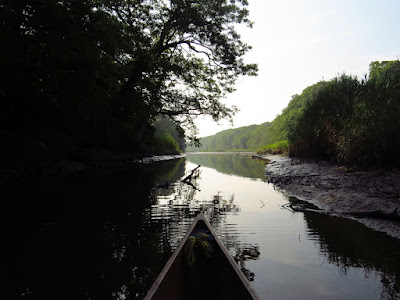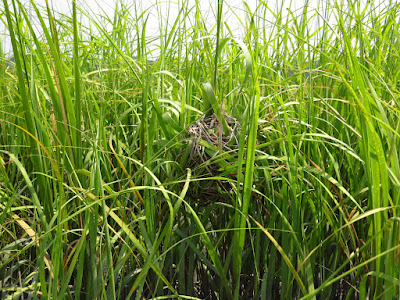A few days of steaming hot weather have passed. Chance of rain and thunderstorms is today's prediction, so I set out for someplace with a bit of protection, just in case.
I put in on the Mattebasset, in the usual spot. Besides having some protection from weather, it seemed to me to be time to check on the beaver population. It is overcast and in the 70's, but the air is quite humid although it does not look at all like it will rain much.
This river looks like perfect beaver habitat, and not only to humans, but to beaver as well. There is plenty of food and building materials with miles of riverbank that is ideal for lodges or bank burrows, and there is a significant buffer from built up areas. There is, however, a problem - the area floods, and it floods big. As I paddle downriver, I think about the numerous beaver lodges that I've seen come and go. I'm pretty sure that it is a rare lodge that has lasted three years, and something like one to two years is more common. When it floods here, the water usually stays up for ten days to two weeks. In one instance, I saw beaver flooded out of their lodge dig new bank burrows on the far side of the river. Of course, when the water level dropped, the bank burrow entrance tunnels were no longer submerged and the burrow was at risk from predators, so the bank burrows were abandoned, and the original lodge was caving in due to the flood.I keep my eyes pealed looking for beaver sign. Before the most recent flood at the end of March, there was a nonstop series of scent mounds for a quarter mile above the Point Lodge. Closer to the lodge were numerous fresh cuts and peals. Today, there is not a single scent mound. There are no fresh peels or cuts, no beaver sticks (branches with the bark peeled off), no sign of any beaver activity. The lodge is still standing and obvious, but it is just a pile of wood without the mud that works as mortar and weather sealing. This lodge was fully submerged in the March flood. Similarly, the bank burrow at the top of Boggy Meadow (the official name of the largest open marsh area) looks abandoned, mainly due to the lack of any active sign in the surroundings.
I wonder how long it will be until new beaver start colonizing this part of the river. Beaver are territorial and two year-old adolescents are kicked out of the parental colony to go find there own place. Eventually, their going to get in here and build a lodge.
I come across a Great Blue Heron about every quarter mile as I head down. I find 4 Great Egrets in Boggy Meadow, noting that the Egrets are not nearly so territorial as the Herons. Kingfishers are also common today. I head down to the Connecticut River and circle Wilcox Island, which lies right off the mouth of the Mattebasset. I flush an immature Bald Eagle from the upper part of the island. Then I head back upriver.
At the top of Boggy Meadow I find a mature Bald Eagle perched over the Tepee Lodge ruins. I get a few photos, and when looking at them later, notice that the Eagle has tags on both legs.
There has been no thunder, no rain, just some fairly pleasant wind to move the humidity about.























